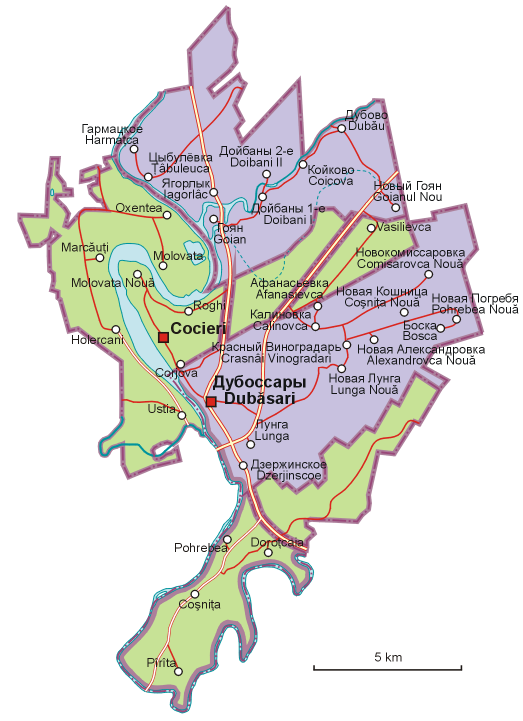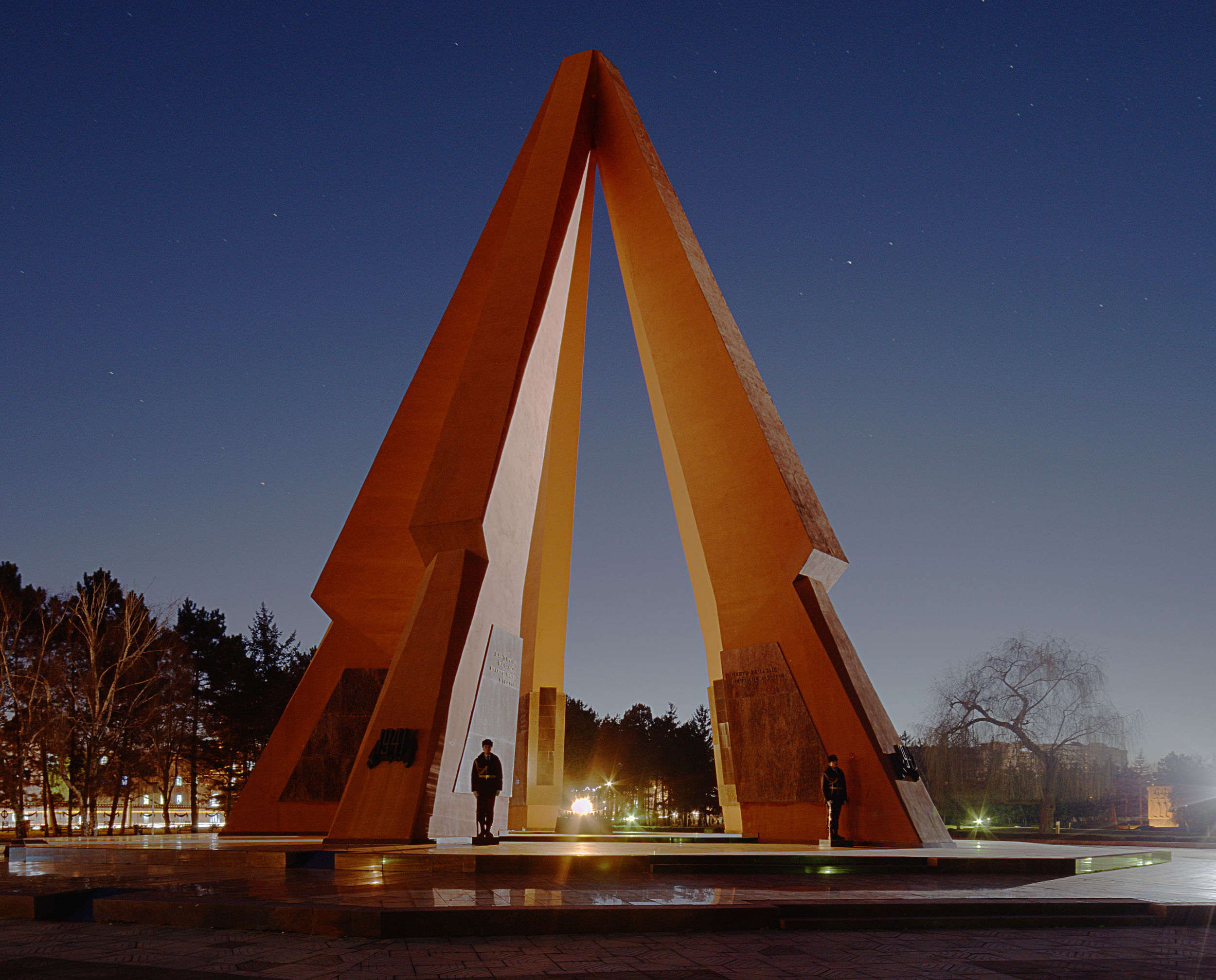|
Doroțcaia
Doroțcaia is a village in the Dubăsari District, Republic of Moldova, situated on the eastern bank of the River Dniester. The village was a place of fighting during 1992 War of Transnistria. It is now under the control of the central authorities from Chișinău. The Grigoriopol Romanian-language school which was not allowed to function by the authorities of Transnistria was moved to the village in 2002. According to the 2014 Moldovan Census, the village had a population of 3,038, of whom 2,976 were ethnic Moldovans, 44 were from ethnic minorities, and 18 were undeclared. Political problems On the eastern edge of Doroțcaia passes the strategic road linking Tiraspol and Rîbnița, and separatist authorities from Tiraspol want to control this road. 85% of Doroțcaia's farmland is across the road. From 2003 Transnistrian authorities tried to prevent farmers from accessing their land. Unable to harvest their crops, the farmers suffered serious losses. This situation lead to an ... [...More Info...] [...Related Items...] OR: [Wikipedia] [Google] [Baidu] |
Dubăsari District
The Dubăsari District () is a Administrative divisions of Moldova, district in the east of Moldova, with the administrative center at Cocieri. As of January 1, 2011, its population was 35,200. This does not include the 715 people that live in the village of Roghi, which is controlled by the Transnistria, breakaway Tiraspol authorities. ''Dubăsari'' means ferry-arks (see coat of arms). History The territory which today is part of Dubăsari district has been inhabited since the Stone Age (50–30000 years BC). Location of the earliest documentary attestation of the district is Corjova, Dubăsari, Corjova, first attested in 1362. Other town with old certificate is Holercani village certified in 1464. This region is part of the Grand Duchy of Lithuania during 1386–1434. In 1393-1812 the part of district, situated on the right, of the Nistru is part of the Principality of Moldova. In this period to develop the economy (trade, agriculture), as population increases. In 1790, the part ... [...More Info...] [...Related Items...] OR: [Wikipedia] [Google] [Baidu] |
War Of Transnistria
The Transnistria War (; ) was an armed conflict that broke out on 2 November 1990 in Dubăsari between pro-Transnistria (Pridnestrovian Moldavian Republic, PMR) forces, including the Transnistrian Republican Guard, militia and neo- Cossack units, which were supported by elements of the Russian 14th Army, and pro-Moldovan forces, including Moldovan troops and police. Fighting intensified on 1 March 1992 and, alternating with ''ad hoc'' ceasefires, lasted throughout the spring and early summer of 1992 until a ceasefire was declared on 21 July 1992, which has held. The conflict is sometimes known as the Moldovan-Russian war () in Moldova and Romania. Background Historical background Before the Soviet occupation of Bessarabia and Northern Bukovina and the creation of the Moldavian SSR in 1940, the Bessarabian part of Moldova, i.e. the part situated to the west of the river Dniester (Nistru), was part of Romania (1918–1940). The Molotov–Ribbentrop Pact between the Sovie ... [...More Info...] [...Related Items...] OR: [Wikipedia] [Google] [Baidu] |
Grigoriopol
Grigoriopol (, , , ) is a town in the Administrative-Territorial Units of the Left Bank of the Dniester, Moldova. It is the seat of the Grigoriopol District of Transnistria. The city is located on the left (eastern) bank of the river Dniester, in central Transnistria. Grigoriopol is composed of the city itself, and a small village ''Crasnoe'' (). The town itself had a population of 11,473 in 2004. In 1996 and in 2002, the town was the centre of a dispute regarding the attempts of local Moldavian inhabitants to use the Romanian language (written with Latin script characters) in the local Moldavian school, which is against the policy of the government of Transnistria. The Transnistrian press attacked the local authorities "that allowed the fifth column of Moldova in Transnistria to operate". The head of the Parent-Teacher Association of the Moldavian school, Mihai Speian, was arrested by the Transnistrian authorities on August 28, 2002. He was released on September 12, followi ... [...More Info...] [...Related Items...] OR: [Wikipedia] [Google] [Baidu] |
Districts Of Moldova
Countries' first-level (top-level) administrative divisions. ''Please note:'' This category's subcategories contain articles on each subdivision of the country while each directly included article considers the subdivisions structure of the country. ''Further note:'' This category's subcategories are indexed according to country, but its directly included articles are not: they are indexed by type of subdivision (provinces, counties, etc). Articles with non-English subdivision terms in their titles either have their redirects indexed instead, or are indexed by the common English translation for said subdivision. This facilitates comparisons between similarly named subdivisions. {{CatAutoTOC Administrative divisions by level and country, 1st-level ... [...More Info...] [...Related Items...] OR: [Wikipedia] [Google] [Baidu] |
National Bureau Of Statistics Of The Republic Of Moldova
The National Bureau of Statistics of the Republic of Moldova (NBS; , abbr. BNS) is the central administrative authority which, as the central statistical body, manages and coordinates the activity in the field of statistics from the country. In its activity, NBS acts according to the Constitution of the Republic of Moldova, the Law on official statistics, other legislative acts, Parliament decisions, decrees of the President of the Republic of Moldova, ordinances, decisions and Government orders, international treaties of which the Republic of Moldova is part of. The NBS elaborates independently or in collaboration with other central administrative bodies and approves the methodologies of statistical and calculation surveys of statistical indicators, in accordance with international standards, especially those of the European Union, and with the advanced practice of other countries, as well as taking into account the peculiarities of the socio-economic conditions of the Republic ... [...More Info...] [...Related Items...] OR: [Wikipedia] [Google] [Baidu] |
Republic Of Moldova
Moldova, officially the Republic of Moldova, is a landlocked country in Eastern Europe, with an area of and population of 2.42 million. Moldova is bordered by Romania to the west and Ukraine to the north, east, and south. The unrecognised breakaway state of Transnistria lies across the Dniester river on the country's eastern border with Ukraine. Moldova is a unitary parliamentary representative democratic republic with its capital in Chișinău, the country's largest city and main cultural and commercial centre. Most of Moldovan territory was a part of the Principality of Moldavia from the 14th century until 1812, when it was ceded to the Russian Empire by the Ottoman Empire (to which Moldavia was a vassal state) and became known as Bessarabia. In 1856, southern Bessarabia was returned to Moldavia, which three years later united with Wallachia to form Romania. but Russian rule was restored over the whole of the region in 1878. During the 1917 Russian Revolution, Bessar ... [...More Info...] [...Related Items...] OR: [Wikipedia] [Google] [Baidu] |
Dniester
The Dniester ( ) is a transboundary river in Eastern Europe. It runs first through Ukraine and then through Moldova (from which it more or less separates the breakaway territory of Transnistria), finally discharging into the Black Sea on Ukrainian territory again. Names The name ''Dniester'' derives from Sarmatian ''dānu nazdya'' "the close river". (The Dnieper, also of Sarmatian origin, derives from the opposite meaning, "the river on the far side".) Alternatively, according to Vasily Abaev ''Dniester'' would be a blend of Scythian ''dānu'' "river" and Thracian ''Ister'', the previous name of the river, literally Dān-Ister (River Ister). The Ancient Greek name of Dniester, ''Tyras'' (Τύρας), is from Scythian ''tūra'', meaning "rapid". The names of the Don and Danube are also from the same Iranian word ''*dānu'' "river". Classical authors have also referred to it as ''Danaster.'' These early forms, without -''i''- but with -''a''-, contradict Abaev's hypoth ... [...More Info...] [...Related Items...] OR: [Wikipedia] [Google] [Baidu] |
Chișinău
Chișinău ( , , ; formerly known as Kishinev) is the Capital city, capital and List of cities and towns in Moldova, largest city of Moldova. The city is Moldova's main industrial and commercial centre, and is located in the middle of the country, on the river Bîc, a tributary of the Dniester. According to the results of the 2014 Moldovan census, 2014 census, the city proper had a population of 532,513, while the population of the Municipality of Chișinău (which includes the city itself and other nearby communities) was 700,000. Chișinău is the most economically prosperous locality in Moldova and its largest transportation hub. Nearly a third of Moldova's population lives in the metro area. Moldova has a Moldovan wine, history of winemaking dating back to at least 3,000 BCE. As the capital city, Chișinău hosts the yearly national wine festival every October. Though the city's buildings were badly damaged during the World War II, Second World War and earthquakes, a rich a ... [...More Info...] [...Related Items...] OR: [Wikipedia] [Google] [Baidu] |
Tiraspol
Tiraspol (, ; also /; , ; , ) is the capital and largest city of Transnistria, a breakaway state of Moldova, where it is the third-largest city. The city is located on the eastern bank of the Dniester River. Tiraspol is a regional hub of culture, economy, tourism, and light industry, such as furniture and electrical goods production. The modern city of Tiraspol was founded by the Russian generalissimo Alexander Suvorov in 1792, although the area had been inhabited for thousands of years by varying ethnic groups. The city celebrates its anniversary every year on 14 October. Etymology The toponym consists of two ancient Greek words: , ''Tyras'', the Classical antiquity, Ancient name for the Dniester River, and ''polis'', i.e., a city (state). History Classical and medieval history Tyras (), also spelled ''Tiras'', was a Greek colonisation, colony of the Greek city Miletus, probably founded about 600 BC, situated some from the mouth of the Tiras River (Dniester). Of n ... [...More Info...] [...Related Items...] OR: [Wikipedia] [Google] [Baidu] |
Rîbnița
Rîbnița ( or , , ) or Rybnitsa (; ) is a town in the breakaway state, breakaway Moldovan region of Transnistria. According to the 2004 Census in Transnistria, 2004 census, it has a population of 53,648. Rîbnița is situated in the northern half of Transnistria, on the left bank of the Dniester, and is separated from the river by a concrete dam. The town is the seat of the Rîbnița District. History Rîbnița was founded in 1628 as the Ruthenians, Ruthenian village Rybnytsia, its name meaning "fishery" (from wikt:рꙑба, рꙑба, "fish"). As early as 1657, Rîbnița was mentioned in documents as an important town. Rybnica, as it was known in Polish, was a private town of the Koniecpolski, Lubomirski, Kożuchowski szlachta, noble families, administratively located in the Bracław County in the Bracław Voivodeship in the Lesser Poland Province, Crown of the Kingdom of Poland, Lesser Poland Province of the Kingdom of Poland. In 1672 it fell to the Ottoman Empire, but was reg ... [...More Info...] [...Related Items...] OR: [Wikipedia] [Google] [Baidu] |
Organization For Security And Co-operation In Europe
The Organization for Security and Co-operation in Europe (OSCE) is a regional security-oriented intergovernmental organization comprising member states in Europe, North America, and Asia. Its mandate includes issues such as arms control, the promotion of human rights, freedom of the press, and free and fair elections. It employs around 3,460 people, mostly in its field operations but also in its secretariat in Vienna, Austria, and its institutions. It has observer status at the United Nations. The OSCE had its origins in 1975: its predecessors came together during the era of the Cold War to form a forum for discussion between the Western Bloc and the Eastern Bloc. Most of its 57 participating countries are in Europe, but with some members in Asia or in North America. The participating countries comprise much of the land area of the Northern Hemisphere. The OSCE is concerned with early warning, conflict prevention, crisis management, and post-conflict rehabilitation. ... [...More Info...] [...Related Items...] OR: [Wikipedia] [Google] [Baidu] |




